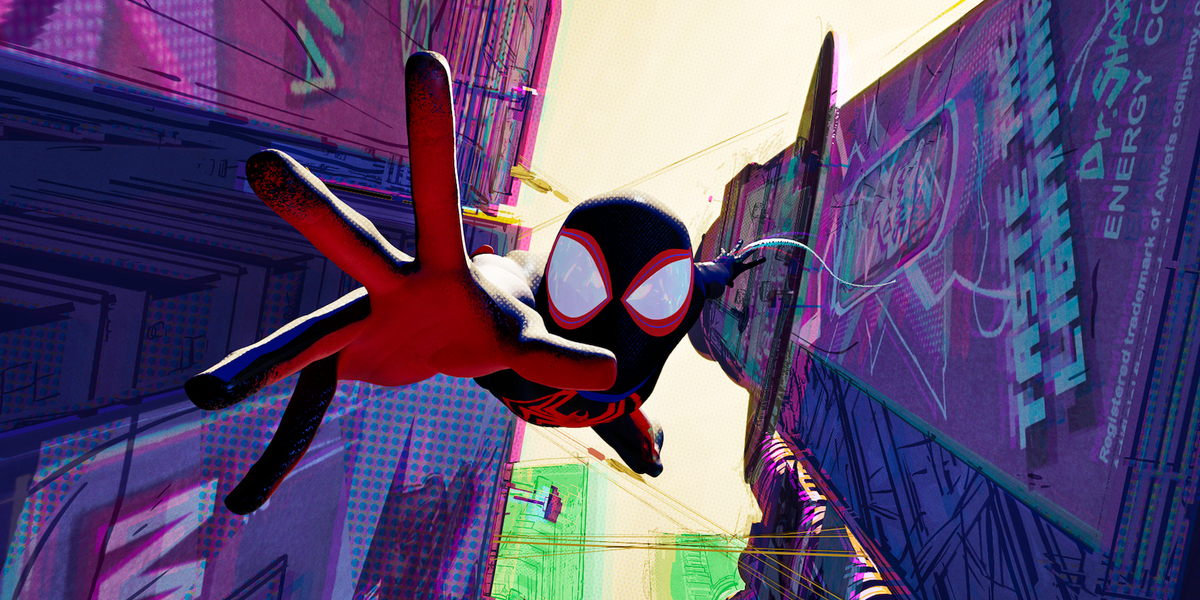Spoilers below.
There’s a moment near the climax of the magnificent animated sequel Spider-Man: Across the Spider-verse in which it seems, perhaps, there might be too many Spider-People. Miles Morales (a fantastic Shameik Moore) is fleeing the Spider-Society headquarters with hundreds, if not thousands, of Spider-Folk from across the multiverse hot in pursuit, including the likes of ringleader Miguel O’Hara (Oscar Isaac), Gwen Stacy (Hailee Steinfeld), Jessica Drew (Issa Rae), Peter B. Parker (Jake Johnson), and—lest he/she/they/it be forgotten—the revved-up Peter Parkedcar.
At the peak of this desperate getaway, Miguel pins Miles to a moving train while the mob approaches, each Spider-Member working to prevent Miles from returning to his home universe and stopping the death of his father, the soon-to-be Police Captain Jeff Davis (Brian Tyree Henry). If he were to do so, he’d upset what this Spider-Society refers to as the “canon,” i.e. the manner in which the story is “supposed to go.” Regardless of whether you’re a Marvel die-hard, you likely know how these Spider-stories tend to work: The uncle dies, as does the police captain, and [insert young Spider-hero] learns the heavy responsibility of power. But now that Miles can anticipate this inciting incident, he’s hellbent on stopping it altogether. And so he unleashes his electricity-zapping powers onto Miguel, tossing the bigger, stronger Spider-Man into the pool of Spider-People like a bowling ball knocking back pins. The clear path provides Miles an escape, and he darts into the air to swing his way home.
The scene is a goofy but apt metaphor for Across the Spider-Verse’s approach to its own franchise-ifcation. The film is a dazzling, retina-blasting spectacle, every new frame an art piece in its own right, the saturation so intense it feels pulled from another universe’s color wheel. On top of that, Across the Spider-Verse features an expansive, ambitious story, both in terms of plot and theme, which it “ends” with the kind of to-be-continued finale that even bigger behemoth franchises have employed ad nauseum. The difference between Across and these other superhero stalwarts is that—as in the scene featuring Miles’ escape—the film actually knows when to pare back the many, many encroaching characters and focus on the story we bought a ticket to see.
Across the Spider-Verse, like Into the Spider-Verse before it and hopefully Beyond the Spider-Verse after it, is ultimately about Miles Morales coming of age. It’s about the moral dilemmas he faces as a charismatic but oft-isolated teenager with a powerful secret and parents who fret over his well-being (particularly as a young Afro-Latino man in America). The other characters—even Steinfeld’s magnetic Gwen Stacy, who gets her own arc in Across—are a mirror to this experience, a way to help Miles recognize his responsibility as a hero, as a friend, and as a son.
What a thrill, then, that the cliffhanger at the end of the film is not the mere fan service audiences have come to expect from Marvel. It serves a purpose beyond keeping the hamster wheel rolling into the next chapter, priming viewers to return to the theater. The final moments see Miles utilize a piece of Spider-Society machinery to analyze his DNA and retro-locate the universe from which his powers originated, transporting him back to its roots so he can find and save his father. The problem with this plan, of course, is that the radioactive spider that bit Miles was an accidental refugee from another universe; as Miguel puts it, Miles was never even meant to become Spider-Man. That spider was intended for someone else, someone who never acquired their Spidey skills because Miles inadvertently stole their venom.
As such, the machine returns Miles to the home universe of the spider, not of Miles himself. After he encounters a slightly-off version of his mother, Rio (Luna Lauren Velez)—she puzzles over why he changed his hair—he starts to comprehend something’s wrong. But the pieces only lock into place after his Uncle Aaron (Mahershala Ali) strolls into the room; after all, Uncle Aaron’s supposed to be dead. But, remember: In this universe, there’s no Spider-Man, and it’s not Aaron but Jefferson Davis who’s memorialized in the family’s rooftop graffiti mural.
Aaron smells something suspicious about our Miles (his hair, for one) and chains the imposter to a punching bag, from which Miles pleads that Aaron doesn’t have to give in to his villainous instincts! He doesn’t have to be The Prowler! The film then pulls off a delicious twist, as Aaron growls: “I’m not.”
Instead, this universe’s Prowler makes his slow approach from the shadows, and when he removes his mask his face matches Miles’ own. (The only distinguishing difference, of course, is their hair.) In this version of reality, there is no Peter Parker, and Miles Morales didn’t have a spider to infuse him with righteous power. Without the hero, he became a villain. That juxtaposition is a perfect encapsulation of our own Miles’ inner journey, as he assesses what it means to become not just a worthy member of the Spider-Society but an independent adult in everyday life. What compromises does such growth demand? Which of them lead to goodness, and which to evil? As Across the Spider-Verse teases its follow-up, it hints not just at a continuation but a true resolution of the franchise’s central dilemma. By pitting Miles versus Miles, it perfects what the series has already spent two films exploring.
The appeal of the multiverse—one that major studios are all too eager to capitalize on—is its capacity to vomit never-ending story. With infinite versions of Spider-Man, there are infinite chapters to explore, and thus infinite properties to monetize. And while Across makes a remarkably solid case for the intrigue of all its Spider-People, the directors (Joaquim Dos Santos, Kemp Powers, and Justin K. Thompson) are smart enough to recognize Miles is the draw here. He’s the keystone. That discretion is what ultimately earns the film the right to its cliffhanger. Watching Across, we realize we can trust that what comes next won’t treat Miles simply as marketable IP; it will treat him like the adult he’s becoming.
Culture Writer
Lauren Puckett-Pope is a staff culture writer at ELLE, where she primarily covers film, television and books. She was previously an associate editor at ELLE.


